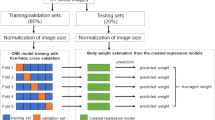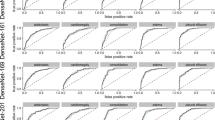Abstract
Accurate body weights are not necessarily available in routine clinical practice. This study aimed to investigate whether body weight can be predicted from chest radiographs using deep learning. Deep-learning models with a convolutional neural network (CNN) were trained and tested using chest radiographs from 85,849 patients. The CNN models were evaluated by calculating the mean absolute error (MAE) and Spearman’s rank correlation coefficient (ρ). The MAEs of the CNN models were 2.63 kg and 3.35 kg for female and male patients, respectively. The predicted body weight was significantly correlated with the actual body weight (ρ = 0.917, p < 0.001 for females; ρ = 0.915, p < 0.001 for males). The body weight was predicted using chest radiographs by applying deep learning. Our method is potentially useful for radiation dose management, determination of the contrast medium dose, and estimation of the specific absorption rate in patients with unknown body weights.




Similar content being viewed by others
Data availability
The code generated during the current study is available from the corresponding author on reasonable request. However, the image datasets presented in this study are not publicly available due to ethical reasons.
References
Fukunaga M, Matsubara K, Ichikawa S, Mitsui H, Yamamoto H, Miyati T. CT dose management of adult patients with unknown body weight using an effective diameter. Eur J Radiol. 2021;135:109483. https://doi.org/10.1016/j.ejrad.2020.109483.
O’Neill S, Kavanagh RG, Carey BW, Moore N, Maher M, O’Connor OJ. Using body mass index to estimate individualised patient radiation dose in abdominal computed tomography. Eur Radiol Exp. 2018;2:38. https://doi.org/10.1186/s41747-018-0070-5.
Bae KT. Intravenous contrast medium administration and scan timing at CT: considerations and approaches. Radiology. 2010;256:32–61. https://doi.org/10.1148/radiol.10090908.
Awai K, Hori S. Effect of contrast injection protocol with dose tailored to patient weight and fixed injection duration on aortic and hepatic enhancement at multidetector-row helical CT. Eur Radiol. 2003;13:2155–60. https://doi.org/10.1007/s00330-003-1904-x.
Seo Y, Wang ZJ. Measurement and evaluation of specific absorption rate and temperature elevation caused by an artificial hip joint during MRI scanning. Sci Rep. 2021;11:1134. https://doi.org/10.1038/s41598-020-80828-7.
Hall WL, Larkin GL, Trujillo MJ, Hinds JL, Delaney KA. Errors in weight estimation in the emergency department: comparing performance by providers and patients. J Emerg Med. 2004;27:219–24. https://doi.org/10.1016/j.jemermed.2004.04.008.
Menon S, Kelly A-M. How accurate is weight estimation in the emergency department? Emerg Med Australas. 2005;17:113–6. https://doi.org/10.1111/j.1742-6723.2005.00701.x.
Fernandes CMB, Clark S, Price A, Innes G. How accurately do we estimate patients’ weight in emergency departments? Can Fam Physician. 1999;45:2373–6.
Ichikawa S, Hamada M, Sugimori H. A deep-learning method using computed tomography scout images for estimating patient body weight. Sci Rep. 2021;11:15627. https://doi.org/10.1038/s41598-021-95170-9.
Yasaka K, Akai H, Kunimatsu A, Kiryu S, Abe O. Prediction of bone mineral density from computed tomography: application of deep learning with a convolutional neural network. Eur Radiol. 2020;30:3549–57. https://doi.org/10.1007/s00330-020-06677-0.
Kojita Y, Matsuo H, Kanda T, Nishio M, Sofue K, Nogami M, et al. Deep learning model for predicting gestational age after the first trimester using fetal MRI. Eur Radiol. 2021;31:3775–82. https://doi.org/10.1007/s00330-021-07915-9.
Sabottke CF, Breaux MA, Spieler BM. Estimation of age in unidentified patients via chest radiography using convolutional neural network regression. Emerg Radiol. 2020;27:463–8. https://doi.org/10.1007/s10140-020-01782-5.
Simonyan K, Zisserman A. Very deep convolutional networks for large-scale image recognition. In: Proceedings of the 3rd International Conference on Learning Representations 2014. http://arxiv.org/abs/1409.1556.
Tang YX, Tang YB, Peng Y, et al. Automated abnormality classification of chest radiographs using deep convolutional neural networks. npj Digit Med. 2020. https://doi.org/10.1038/s41746-020-0273-z.
Keidar D, Yaron D, Goldstein E, et al. COVID-19 classification of X-ray images using deep neural networks. Eur Radiol. 2021;31:9654–63. https://doi.org/10.1007/s00330-021-08050-1.
Usman M, Zia T, Tariq A. Analyzing transfer learning of vision transformers for interpreting chest radiography. J Digit Imaging. 2022;35:1445–62. https://doi.org/10.1007/s10278-022-00666-z.
Krizhevsky A, Sutskever I, Hinton GE. ImageNet classification with deep convolutional neural networks. Commun ACM. 2017;60:84–90. https://doi.org/10.1145/3065386.
Kingma DP, Ba J. Adam: a method for stochastic optimization. In: Proceedings of the 3rd International Conference for Learning Representations 2014. https://arxiv.org/abs/1412.6980.
Selvaraju RR, Cogswell M, Das A, Vedantam R, Parikh D, Batra D. Grad-CAM: visual explanations from deep networks via gradient-based localization. In: Proceedings of the IEEE International Conference on Computer Vision. 2017. https://doi.org/10.1109/ICCV.2017.74.
Buckley RG, Stehman CR, Dos Santos FL, Riffenburgh RH, Swenson A, Mjos N, et al. Bedside method to estimate actual body weight in the emergency department. J Emerg Med. 2012;42:100–4. https://doi.org/10.1016/j.jemermed.2010.10.022.
Geraghty EM, Boone JM. Determination of height, weight, body mass index, and body surface area with a single abdominal CT image. Radiology. 2003;228:857–63. https://doi.org/10.1148/radiol.2283020095.
Gascho D, Ganzoni L, Kolly P, Zoelch N, Hatch GM, Thali MJ, et al. A new method for estimating patient body weight using CT dose modulation data. Eur Radiol Exp. 2017;1:23. https://doi.org/10.1186/s41747-017-0028-z.
Yamada Y, Yamada M, Chubachi S, Yokoyama Y, Matsuoka S, Tanabe A, et al. Comparison of inspiratory and expiratory lung and lobe volumes among supine, standing, and sitting positions using conventional and upright CT. Sci Rep. 2020;10:16203. https://doi.org/10.1038/s41598-020-73240-8.
Acknowledgements
The authors would like to thank Enago (www.enago.jp) for the English language review.
Funding
This work was supported with funding by the Kurashiki Clinical Research Institute, Ohara HealthCare Foundation.
Author information
Authors and Affiliations
Contributions
SI contributed to the study design, data collection, algorithm construction, and the writing and editing of the article; HI carried out the data collection, and the reviewing and editing of the article; HS performed supervision, project administration, and reviewing and editing of the article. All the authors read and approved the final manuscript.
Corresponding author
Ethics declarations
Conflict of interest
The authors declare that they have no competing interests.
Ethical approval
This study was performed in line with the principles of the Declaration of Helsinki. Approval was granted by the institutional review board of Kurashiki Central Hospital. The requirement for individual informed consent was waived due to the retrospective nature of the study.
Additional information
Publisher's Note
Springer Nature remains neutral with regard to jurisdictional claims in published maps and institutional affiliations.
About this article
Cite this article
Ichikawa, S., Itadani, H. & Sugimori, H. Prediction of body weight from chest radiographs using deep learning with a convolutional neural network. Radiol Phys Technol 16, 127–134 (2023). https://doi.org/10.1007/s12194-023-00697-3
Received:
Revised:
Accepted:
Published:
Issue Date:
DOI: https://doi.org/10.1007/s12194-023-00697-3




